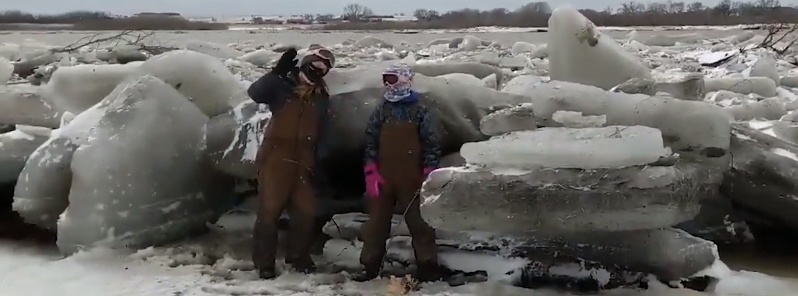Catastrophic flooding caused by rapid snowmelt and heavy rain, agriculture devastated, U.S.

Rapid snowmelt and heavy rain combined to produce massive flooding across Nebraska, Iowa, Kansas, Wisconsin and South Dakota.
Historic to catastrophic flooding inundated homes and businesses and devastated farmlands following a powerful late-season winter storm that swept through the country last week.
The massive flooding event was triggered by a rare combination of rapid snowmelt, ice-covered rivers, saturated frozen soil, and heavy rain from the so-called "Bomb Cyclone" or Winter Storm "Ulmer," as it was named by The Weather Channel.
The magnitude of the #Nebraska floods caused by snowmelt is biblical
#Sentinel2 image acquired on 16 March
reference image from February
See the animations below pic.twitter.com/DVfhOe1OE3— Copernicus EU (@CopernicusEU) March 17, 2019
#NebraskaFloods seen by #Sentinel2 pic.twitter.com/bKKlVSVcCM
— Copernicus EU (@CopernicusEU) March 17, 2019
Further north on the Missouri River.
Farms inundated. pic.twitter.com/Mf8lw3RqCd
— Dakota Smith (@weatherdak) March 17, 2019
Snow melt to swollen rivers.
Extensive flooding in Iowa & Nebraska. pic.twitter.com/ELUU8rA9jM
— Dakota Smith (@weatherdak) March 16, 2019
Flooding near Waterloo this morning. #NebraskaFlood pic.twitter.com/3ofBxFOirw
— Gov. Pete Ricketts (@GovRicketts) March 16, 2019
Highway 281 bridge. #NebraskaFlood pic.twitter.com/leUFQGfR2y
— Gov. Pete Ricketts (@GovRicketts) March 16, 2019
Spencer Dam. #NebraskaFlood pic.twitter.com/yWHBLVgL7C
— Gov. Pete Ricketts (@GovRicketts) March 16, 2019
.@SenSasse and I joined @NENationalGuard to get an aerial view of flooding impact as we traveled to thank volunteers in Fremont, address a community meeting in Niobrara, and receive a briefing in Lynch. More here: https://t.co/78cd5jkTOG#NebraskaFlood | #NebraskaStrong pic.twitter.com/h32kyx0NE4
— Gov. Pete Ricketts (@GovRicketts) March 16, 2019
Thousands of people were forced to evacuate their homes as floodwaters washed out bridges, submerged homes and highways.
In addition, agriculture across the region has been devastated, cattle stranded on newly formed islands and hay fields taken over by giant chunks of ice:

From blizzards to tornadoes to floods…
I put together a quick recap of last week's historic storm system.
Full video: https://t.co/PrUGtflDRV pic.twitter.com/GZA4hvE6p3
— Dakota Smith (@weatherdak) March 17, 2019
Heart-wrenching video out of Fullerton, Nebraska.
Cow rescued from the mud after floodwaters receded. pic.twitter.com/VfNAhSEv2W
— Dakota Smith (@weatherdak) March 18, 2019
Three fatalities have been confirmed and at least two others remain missing as of early Monday morning, March 18.
In addition to the statewide emergency declaration issued by Nebraska Governor Pete Ricketts, 53 counties, 54 and two tribes have issued emergency declarations. A state of emergency has also been declared in Kansas, Wisconsin and Iowa.




While river depths were starting to level off in parts of Nebraska on Sunday, March 17, the water is so high in many places that serious flooding is expected to remain for several days. And downstream communities in Kansas and Missouri were bracing for likely flooding, the AP reported March 18.
"Major to historic river flooding is expected to continue across parts of the Missouri and Mississippi River Basins due to rapid snowmelt the past few days," NWS forecaster Santorelli said March 18.
Flood warnings and advisories remain in effect, mainly across eastern Nebraska and into parts of Iowa.
Flooding is also a concern across parts of the Northern Great Basin into the Northern/Central Rockies as warmer than average temperatures lead to accelerated snowmelt for the lower elevations.
Featured image credit: Jared Jaixen

Hi,
I can explain it to you, once and for all.
Think of global climate as a car engine. Global warming means the Sun is adding higher octane to its fuel.
Before it burns the planet out completely, it will move more water away from drought-struck places and towards the flood-prone. It will move more cold and more heat with faster and more extensive winds, both in their season and unseasonably.
Think of this biblical reference: “To those who have, more will be given; to those without, what they have will be taken away.” Until the Earth bakes sterile.
Figure it out, and cooperate with crash remediation or die with your loved ones and everyone else.
Is that clear enough?
Why is global warming so cold????Mr.Al Gore
Why does the whole world pay Trillions of dollars in global warming taxes,and we just get more ice for the price????
Can someone explain that to me??